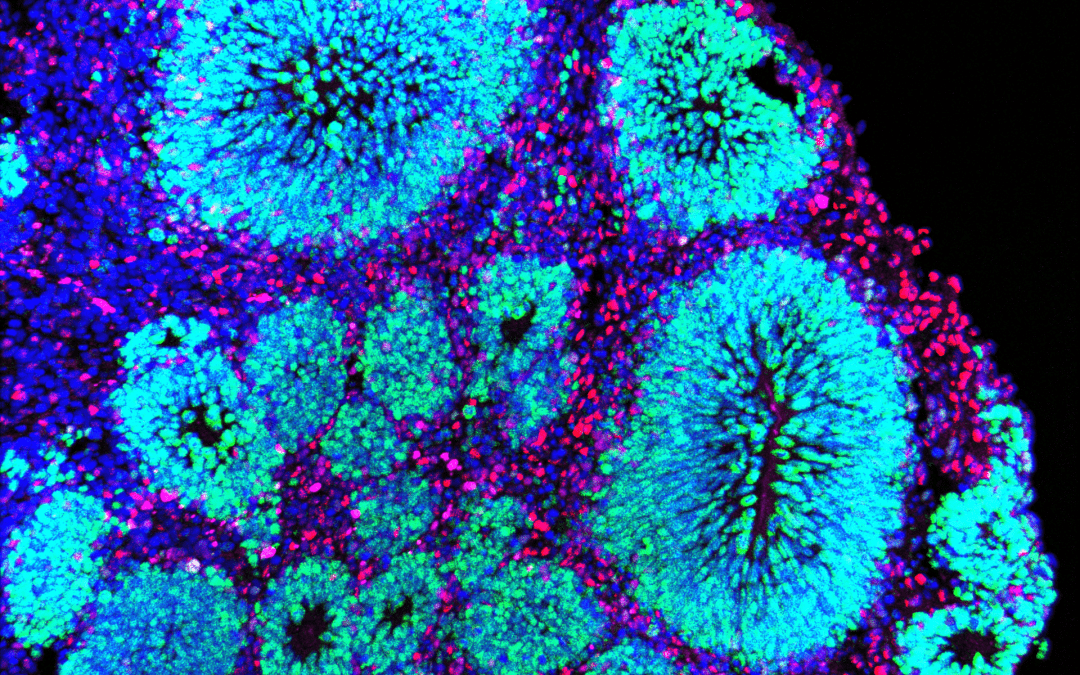March 22, 2023
Today is World Organoid Research Day! Researchers at the UC Santa Cruz Genomics Institute have been working with brain organoids for years in an attempt to better understand the human brain. To raise awareness of these very special cell clusters, we put together the following Q&A:
What is an organoid?
If you’ve never heard of an organoid before, you’re not alone. Researchers have only been able to cultivate them for a little more than a decade, but they hold a lot of potential for medicine and physiology.
An organoid is a three-dimensional cluster of cells that have some level of architecture and connectivity similar to a particular organ. They are artificially grown from stem cells, and different labs study different types of organoids such as lung organoids, retinal organoids, cancer organoids, and organoids related to nearly every other organ of the body. Our Braingeneers group at the UC Santa Cruz Genomics Institute does research on brain organoids.
Why are organoids important enough to have their own day?
Organoids can tell us a lot about how the body works that we simply cannot learn from looking at two-dimensional cell cultures. In brain organoids for example, we are able to observe certain types of brain architecture, connectivity, and even cell types that we were not able to create before and cannot observe in living humans or even animals. For example, UC Santa Cruz Professor of Biomolecular Engineering Ed Green participated in a study that used select genes from the Neanderthal genome to grow neanderthal brain organoids to better understand how the human brain evolved.
Are organoids mini-organs?
No. We work with brain organoids, and although they contain important brain cells, they lack the connectivity, vascular systems, and cell-types necessary to be a real organ.

A brain organoid grown by the Braingeneers group. The different colors are produced by antibody dyes that cling to specific genes, in this case FEZF2, PAX6, and SOX2. The presence of these three genes indicates the development of the cortical area of the brain in the organoid, including cortical progenitors and corticospinal neurons.
Are brain organoids conscious?
Don’t worry, we are in no way creating conscious entities in a lab! Brain organoids have only some of the characteristics of a brain, but are not even close to being whole functioning brains. Consciousness requires certain wave-lengths that have not been observed in brain organoids. The same way doctors know whether a person who is in a coma still has consciousness or not, we can tell that organoids do not have the wave-lengths required for conscious thought.
What are the Braingeneers?
The Braingeneers is a research group made up of the UC Santa Cruz Haussler-Salama Lab, Teodorescu Lab, Mostajo-Radji Lab and Sharf Lab in collaboration with UCSF, UCSB, and Washington University in St. Louis, are working on using organoids to better understand the brain, and also creating the technologies needed to scale up production of organoids. This is important because human brain organoids take months to develop and require very specific conditions to stay alive, but recent advances from the Braingeneers group are helping to automate the process. The Braingeeners are also studying how the brain develops, how it has evolved and how brain circuits form.
A unique aspect of the Braingeneers group is that it is a consortium that brings together neuroscientists, geneticists, and engineers. In most universities, these fields are separated in different buildings, but here we have them sharing the same physical lab space, which has led to some very productive research.
Who can conduct organoid research?
The UC Santa Cruz Genomics Institute is on a quest to bring organoid research to the masses by connecting them to the cloud. Their new Live Cell Biotechnology Discovery Lab has worked on creating technology to bring lab experiments with living cells to students in under-resourced areas around the world. They have been piloting this technology in a local high school for several years, and this April they will begin the first remotely controlled laboratory for organoid research for smaller universities and liberal arts colleges in San Francisco.


Recent Comments